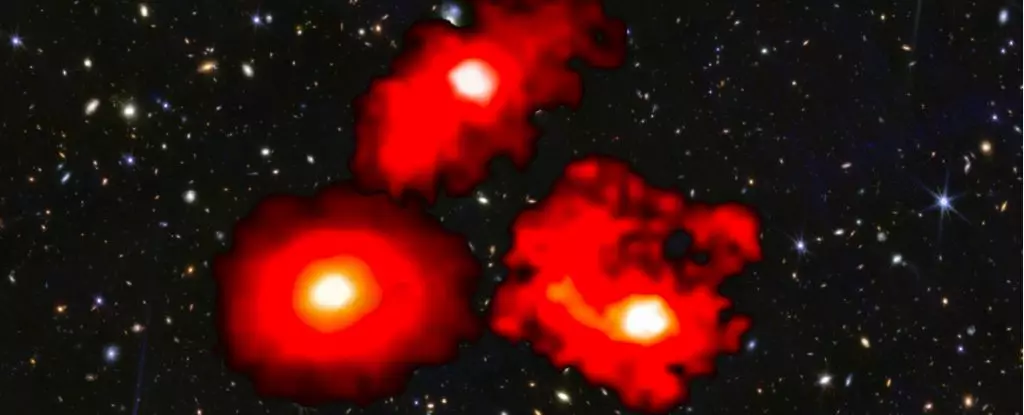Recent astronomical findings have unveiled a puzzling phenomenon in the early Universe: what are being referred to as ‘red monsters.’ These massive galaxies, remarkable for their size, rival the Milky Way despite having formed shortly after the Big Bang. This discovery has sent ripples through the scientific community, challenging long-held beliefs about galaxy formation. Traditionally, astronomical models suggested that it would take considerable time for such enormous structures to come into being. However, these observations hint at a more complex narrative regarding the evolution of galaxies in the infant cosmos.
The James Webb Space Telescope (JWST) has been pivotal in revealing previously unseen cosmic phenomena. As light from distant galaxies stretches into infrared wavelengths due to the expansion of the Universe, JWST has provided unprecedented clarity to observations of the Cosmic Dawn, the period of roughly the first billion years post-Big Bang. Prior to its launch, astronomers faced challenges in gathering concrete observational evidence about this crucial era. Now, the JWST’s capabilities are leading to transformative insights into the formation and growth of primordial galaxies.
According to current models, galaxy formation involves the gravitational attraction of dark matter and baryonic matter—essentially the normal matter we can observe. Over time, these matter emissions coalesce, leading to the birth of stars and the establishment of galaxies. However, the timeframe considered for these processes has been deemed too long for the ‘red monsters’ to exist during such an early epoch. The emergence of these gargantuan galaxies raises critical questions regarding the mechanisms that underpin their formation.
Ivo Labbé, an astronomer from Swinburne University, likens the findings to the incongruity of spotting a toddler weighing over 100 kilograms. This analogy underscores the bewilderment faced by astronomers: massive galaxies appearing almost immediately after the Big Bang confound conventional theories of cosmic evolution. Although several potential explanations have been posited, none have comprehensively resolved the paradox these galaxies present.
One hypothesis suggests that these early galaxies may not be as substantial as initially perceived, but rather that bright emissions from material near their supermassive black holes create an illusion of size. Indeed, recent findings indicate that black holes can emit significant amounts of light, potentially allowing these galaxies to appear larger than they truly are. Yet, new research from astronomer Mengyuan Xiao at the University of Geneva sheds light on the contrary—the physical characteristics of at least some ‘red monsters’ affirm that they are genuinely massive structures.
The discoveries stem from observations made under JWST’s FRESCO (Faint Redshifted Objects in the Cosmic Dawn) program, which aims to acquire detailed measurements on the distances and masses of early galaxies. While the majority of galaxies investigated align with prevailing cosmic models, the emergence of these three ‘red monsters’ signals a need to rethink our frameworks. They stand out not merely as anomalies but as indicators that the processes governing galaxy formation may be more dynamic and rapid than previously understood.
These three galaxies show a rate of star formation significantly higher than that of contemporary star-forming galaxies. This revelation poses notable implications for established models of star formation, as a vigorous galaxy should exhibit feedback mechanisms that hinder the continual accumulation of stellar materials. The question arises: what unknown faculties in the early Universe allowed for such prolific star formation rates?
The findings challenge existing models related to the rate of star formation, as astronomers struggle to account for how such efficiency could occur in the early Universe, particularly in light of the expected destructive forces such as supernovae and intense black hole activity that generally limit stellar growth. Labbé emphasizes this complexity, stating that conventional models fail to explain the coexistence of rapid star formation and the energetic feedback mechanisms that typically slow it down.
As research continues and more data is gathered, the scientific community stands on the precipice of transforming its understanding of cosmic evolution. If these massive galaxies do indeed possess the rates of star formation suggested by current observations, then new models will need to be developed to incorporate these complexities into a coherent narrative of the early Universe.
The discovery of ‘red monsters’ opens a Pandora’s box of questions regarding the Universe’s infancy. With the aid of the JWST, astronomers are better equipped to unearth the cosmic secrets that have eluded them for decades. This remarkable finding not only enriches our understanding of galaxy formation but challenges the paradigms that frame our knowledge of the Universe. Our comprehension of cosmic history may soon evolve, driven by these discoveries in the ever-expanding realm of astrophysics.

